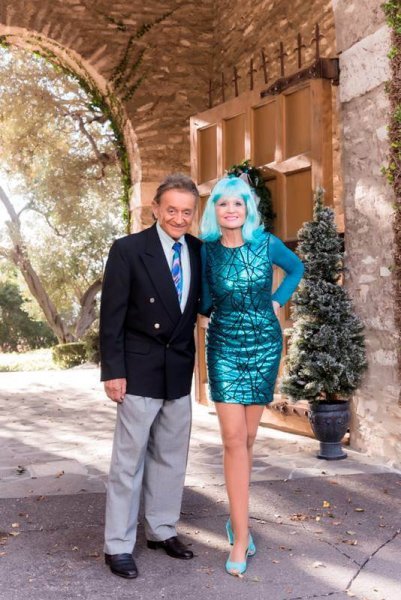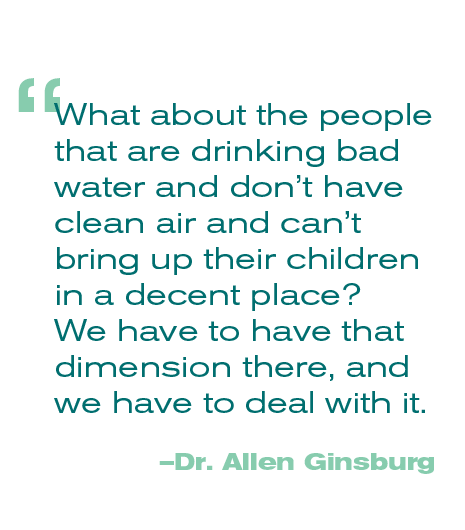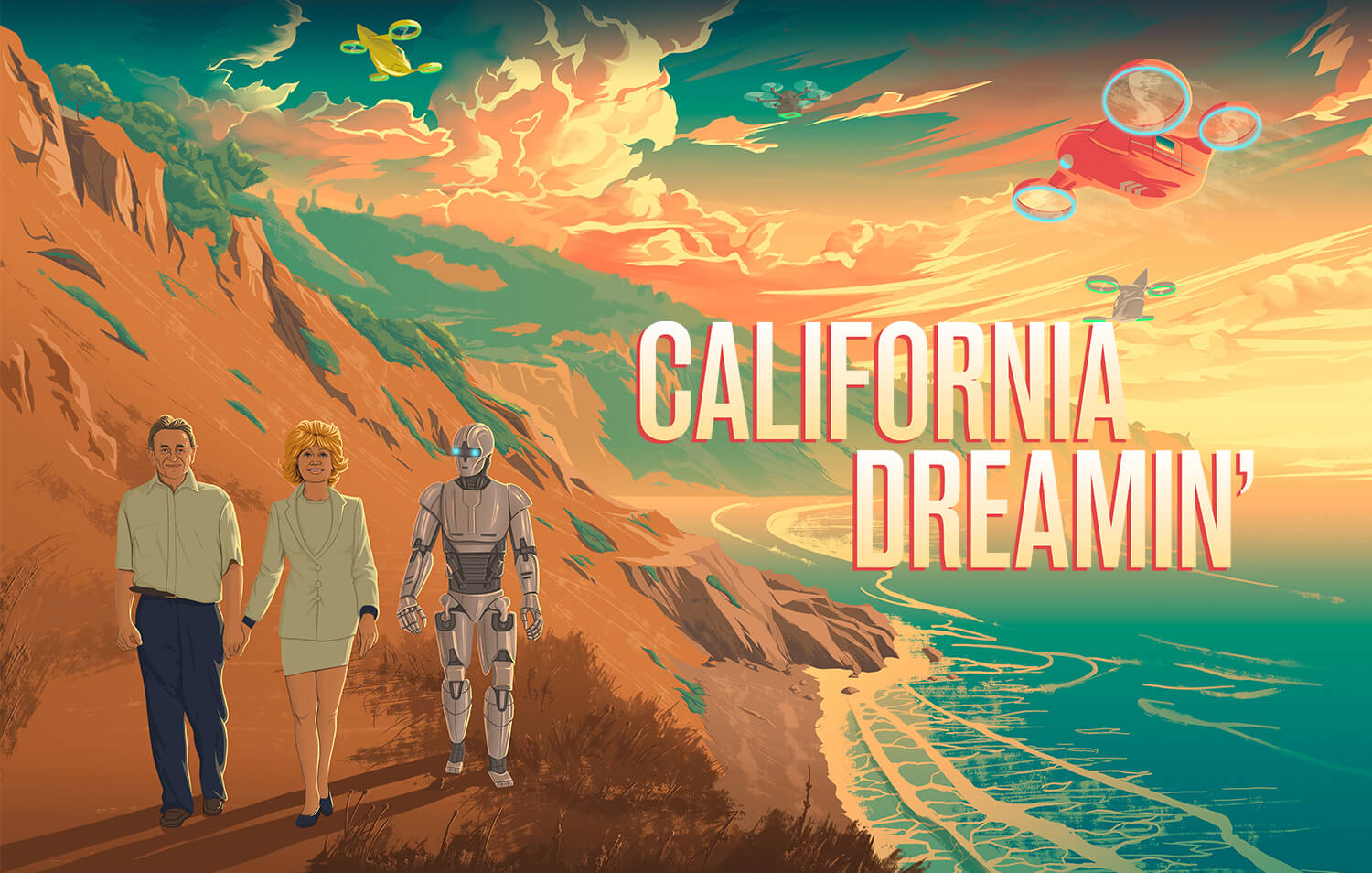California Dreamin’
DR. ALLEN GINSBURG saw his first computer in Rockefeller Center at age 16.
It was enormous – about the height of Shaquille O’Neal. Allen remembered you could take a tour behind the scenes, place a punch card in the gigantic IBM machine, and it would spit out answers.
By the time his wife, Charlotte Ginsburg, met Allen in 1980, the Los Angeles-based ophthalmologist had several large computers at his business, used for logging patient data rather than on handwritten charts. They were the first computers she remembers seeing in real life.
They were not very good at the job, though. “I definitely regretted spending the money,” Allen recalled. “The technology wasn’t quite ready for what we needed it to do.”
Fast forward to 2020: Allen’s most beloved object is a computer. An iPhone X than can fit in his pocket and has more computing power than all of NASA in 1969.
What changed?
For Allen, it was 2003. That year, after two decades and $3 billion of work, scientists discovered the blueprint for human beings: the human genome.
Said Allen, “It means that if you have a condition – cancer, diabetes, you can go into the double helix of DNA and edit those genes. You could exchange good for bad traits, and also expect for it to be passed on to your progeny.”
It was a breakthrough, Allen noted, that was only possible due to computers — hundreds of networked computers and supercomputers, to be exact.
Neither Allen nor Charlotte is a computer scientist. But both, in recent years, recognized that computers — these strange boxes that shrank from a whole room in Rockefeller Plaza to Allen’s pocket — are the game changers in everything from health care to pollution to homelessness.
And so, in January 2020, they made their gift. A new home for computer science at the USC Viterbi School of Engineering: the 98,000-square foot Dr. Allen and Charlotte Ginsburg Human-Centered Computation Hall.
The Philanthropist Wears Peacock Feathers
 Charlotte has always loved theater and fashion. Even today, she makes Broadway style, feathered hats, many with vibrant peacock feathers.
Charlotte has always loved theater and fashion. Even today, she makes Broadway style, feathered hats, many with vibrant peacock feathers.
Growing up, Allen never celebrated birthdays or holidays. He was content with a roof over his head and a card to the library five blocks away. Charlotte, however, had other ideas.
Much like her father, Charlotte knows how to throw a party. There was the “King and I” soiree where music accompanied the grand entrance of Allen and Charlotte, bedecked in crowns and red finery. There was the Beverly Hilton bash where a Marilyn Monroe lookalike awarded Allen an Oscar. There were events with hundreds of guests, including senators, mayors, dancers and musicians.
“It’s very difficult for anybody to say no to Charlotte,” said Allen with a smile.
But it was Charlotte who then turned those immense energies outward, like a spellcaster re-directing lightning. Her philanthropic energies span from the Long Beach Symphony to Save the Redwoods and the Palos Verdes Land Conservancy — their Heritage Castle on the peninsula is a sanctuary of history and nature. She’s even found innovative ways to unite art and science. In 2012, for example, as a board member of the Aquarium of the Pacific and longtime supporter of the Long Beach Ballet, she helped organize their first joint production: an immersive ballet surrounded by swaying kelp and scorpionfish in the aquarium’s Great Hall.
The Ginsburgs were already agents of convergence. But they envisioned something grander.
Ophthalmology and helping patients restore their vision had always been Allen’s first career. “Ophthalmology was a field where, hey, you got a cataract, we can remove it,” said Allen. “We can give you your vision back. People are so thankful they got down on their knees to kiss your hand. I thought I was the pope.”
But Allen never forgot the other patients, either. The ones with macular degeneration with whom he had to share the inevitable news: you’re going blind, and there’s nothing more I can do.
“It’s devastating,” said Allen, “and the most stressing distressing thing is the high incidence of suicide.”
So Charlotte visited some of the top eye institutes in the country, including Bascom Palmer at the University of Miami, the Kellogg Eye Center at the University of Michigan and the Jules Stein Institute at UCLA.
“Lady Charlotte is the one who did the heavy lifting,” said Allen. “She met these people, she made a connection with them, and it was very easy for us to feel comfortable and doing the things we’re doing.”
In the end, the answer was right in their own backyard.
Dr. Mark Humayun, a USC professor of ophthalmology, biomedical engineering, and integrative anatomical sciences, co-invented the Argus II, the first FDA approved device to restore sight to the blind. Named by USA Today as one of the top 25 greatest inventions of the new millennium, the artificial retina has allowed people who were blind for 50 years to see again.
For Allen and Humayun, it was like the first meeting of Barnum and Bailey. Charlotte invited Humayun to their home in Rancho Palos Verdes with a beautiful view of the San Pedro harbor.
They never looked at the view.
Instead, both men found themselves excitedly re-imagining being together in the operating room.
Allen described how he used to do cataract surgeries – making an incision in the eye that was often so large that patients would be bedridden for weeks with sand bags around their heads so they wouldn’t roll over on the surgically repaired eye. He listened in amazement as Humayun described more recent advances: putting the Argus 2 microelectronic implant in the eye and going home the very same day.
As Charlotte and Allen now reflect on it: “It was one of the great moments in our lives that we both shared together.”
In May 2018, the Ginsburgs announced their first gift to USC: the USC Institute for Biomedical Therapeutics (IBT). The new research fund brought together scientists, engineers, physicians and other faculty from across USC to develop new ways to diagnose and treat diseases that cause debilitating blindness, as well as other neurosensory disorders. Humayun was named the inaugural director.
Said Humayun, “They’re such a great team. Charlotte is the one who really finds these opportunities. She has the heart of an amazing philanthropist. Then she’ll share these with Allen, and he’s very futuristic, very quantitative. He’ll ask questions like, ‘Is it 10-9 or 10-10?’ They both clearly realize and appreciate the advances of science and medicine.”
But they weren’t done.
California Dreamin’
“California dreamin’ (California dreamin’)…On such a winter’s day.”
— The Mamas and The Papas (1965)

The Ginsburgs have a habit of taking the long view.
“Allen is really a futurist,” said Charlotte. “Thirty-five years ago, he said, ‘Let’s get solar,’ and I said, ‘Well, what’s that?’ And so, he explained it to me and we looked around for someone in California to install our solar panels. But no one in California did it. So we had to go to North Carolina and have all the equipment shipped here. And we were the first in our neighborhood, I think, in our town, to have solar.”
Said Allen: “The panels covered our entire roof and were 1% efficient with unreliable inverters, which miraculously worked. In fact, we had chairs for people to see our electric meter turning backwards, which was the rage at the time.”
A few years later, Allen turned to Charlotte and said, “I’ve been reading about artificial turf. You know, we could save a lot of water and help the planet out.”
So the Ginsburgs started adding artificial turf to their growing real estate empire.
These days, Allen’s mind is humming with thoughts on nuclear power: “in spite of Three Mile and Chernobyl, it’s the safest 24/7 energy we’re going to get.” Robot-driven space exploration: “We’re not made for space. But a robot with artificial intelligence can do all these things.” Or air pollution: “You go 10 to 15 miles inland, and you’re already in part of Los Angeles that decreases your life three to five years. In fact, recently, the pathologist says it’s closer to five to seven years.”
As Humayun noted: “Their interests go far beyond medicine.”
In their view, the new Dr. Allen and Charlotte Ginsburg Human-Centered Computation Hall unites together so many things. First, there’s it’s physical location on the USC campus — part of a trinity of advanced research buildings that Gaurav Sukhatme, USC Viterbi’s executive vice dean, calls “the trifecta.” The three buildings — Irani Hall, Michelson Hall and the future Ginsburg Hall — will be physically adjacent in USC’s southwest quadrant of campus. Sukhatme, the Fletcher Jones Foundation Endowed Chair in Computer Science, played a key role in the building’s genesis and overall vision.
“Imagine,” said Sukhatme, “sequencing your genome in nearby Irani Hall, analyzing unique biomarkers for disease with computers at Ginsburg Hall and then finally imaging gene expression over at Michelson Hall.”
The new Ginsburg Hall will, of course, be a new home to computer science at USC — a program ranked among the top 10 in the world for academic research by Microsoft. It will house cutting-edge socially assistive robotics, quantum computing and the Center for Artificial Intelligence in Society (CAIS), one of the leading “AI for social good” research centers in the U.S.
When future students pass through the doors that bear their names, here’s what Charlotte would like them to know about the Ginsburgs:
“We had a great run. And a fantastic life. We hope you give back to people now and in the future — so that they live as long and healthy life as we have.”
 A Very Ginsburg Future
A Very Ginsburg Future
O heaven! That one might read the book of fate, and see the revolution of the times.
— “Henry IV, Part 2” Act 3, Sc. 1
As enamored as the Ginsburgs are with robots and AI, it’s the human dimension that interests them most. Thus the name — Ginsburg Human-Centered Computation Hall.
Said Allen, “The human aspect is often the thing we think about the least because we get so excited. Well, gee, look what’s happening with robotics. What’s happening with artificial intelligence. Fantastic. Well, what about the people that are in poverty? What about the people that are drinking bad water and don’t have clean air and can’t bring up their children in a decent place? We have to have that dimension there, and we have to deal with it.”
Allen has been engrossed by the human condition — as he says, “the hopes, dreams, the beautiful, the ugly, love, hate, avarice, obsequiousness of humans” — ever since he devoured the works of Shakespeare, Faulkner and Tolstoy as a child.
For all his love of technology, Allen will never forget the three weeks he spent in Japan in 1952.
“It was one of the worst times of my life,” said Allen.
As a University of Michigan student studying radiation, he saw the effects firsthand in Hiroshima and Nagasaki. Eight years after the bombs dropped, Allen saw a devastated people dying from radiation. Thyroid tumors in the children. Cows with contaminated milk.
“We got the whole story of people burning internally from radiation,” said Allen, “trying to get to the river. They wanted to drown. Just to get away from the pain. I woke up at night. Not all the time, but when I do, I can recollect what happened. What radiation did to people.”
The questions that the computers in the Ginsburg building will answer are many times more complex and ambitious than the ones posed to the IBM machine at Rockefeller Center. But at the end of the day, amidst all the drones and machine learning and Granger causalities, those questions can be best distilled as:
How can computing improve human lives?
Charlotte and Allen are bullish that Trojan engineers can help find the answers.
“We characterize ourselves as realists caught up in the embellishments of humanity,” Allen said. “We love science and attribute the greatness of our country to scientific achievements: winning World War 2, nuclear energy, getting to the moon, cell phones, the movie industry, sequencing the genome and now CRISPR — our scientific achievements lead the world.”




